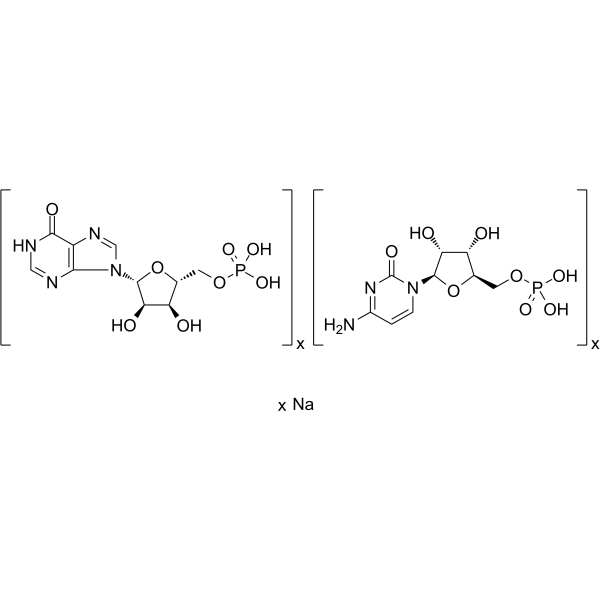上海金畔生物科技有限公司为生命科学和医药研发人员提供生物活性分子抑制剂、激动剂、特异性抑制剂、化合物库、重组蛋白,专注于信号通路和疾病研究领域。
Polyinosinic-polycytidylic acid sodium (Synonyms: Poly(I:C) sodium) 纯度: ≥98.0%
Polyinosinic-polycytidylic acid sodium (Poly(I:C) sodium) 是双链 RNA 的合成类似物,是一种 TLR3 和视黄酸诱导型基因 I 受体 (RIG-I 和 MDA5) 的激动剂。Polyinosinic-polycytidylic acid sodium 可以用作疫苗佐剂,以增强先天性和适应性免疫反应,并改变肿瘤的微环境,还可以直接触发癌细胞发生凋亡。

Polyinosinic-polycytidylic acid sodium Chemical Structure
CAS No. : 42424-50-0
| 规格 | 价格 | 是否有货 | 数量 |
|---|---|---|---|
| 10 mg | ¥2800 | In-stock | |
| 25 mg | ¥5000 | In-stock | |
| 50 mg | 询价 | ||
| 100 mg | 询价 |
* Please select Quantity before adding items.
Polyinosinic-polycytidylic acid sodium 相关产品
•相关化合物库:
- Bioactive Compound Library Plus
| 生物活性 |
Polyinosinic-polycytidylic acid sodium (Poly(I:C) sodium) is a synthetic analog of double-stranded RNA and an agonist of toll-like receptor 3 (TLR3) and retinoic acid inducible gene I (RIG-I)-like receptors (RIG-I and MDA5). Polyinosinic-polycytidylic acid sodium can be used as a vaccine adjuvant to enhance innate and adaptive immune responses, and to alter the tumor microenvironment. Polyinosinic-polycytidylic acid sodium can directly trigger cancer cells to undergo apoptosis[1][2]. |
||||||||||||||||||||||||||||||||
|---|---|---|---|---|---|---|---|---|---|---|---|---|---|---|---|---|---|---|---|---|---|---|---|---|---|---|---|---|---|---|---|---|---|
| IC50 & Target |
|
||||||||||||||||||||||||||||||||
| 体外研究 (In Vitro) |
Polyinosinic-polycytidylic acid (20 ng/mL; 24 hours; WM793, WM278, WM239A, WM9 and 1205Lu cells) treatment strongly reduces viability from 100% in controls to 20%–50% within 24 hours[1]. 上海金畔生物科技有限公司 has not independently confirmed the accuracy of these methods. They are for reference only. Cell Viability Assay[1]
Apoptosis Analysis[1]
RT-PCR[1]
Western Blot Analysis[1]
|
||||||||||||||||||||||||||||||||
| 体内研究 (In Vivo) |
Polyinosinic-polycytidylic acid treatment inhibits tumor growth in NOD/SCID immunodeficient mice injected with 1205Lu cells. The level of human DNA is 50% lower in mice treated with Polyinosinic-polycytidylic acid[1]. 上海金畔生物科技有限公司 has not independently confirmed the accuracy of these methods. They are for reference only. |
||||||||||||||||||||||||||||||||
| Formula |
(C10H13N4O8P)x.(C9H14N3O8P)x.xNa |
||||||||||||||||||||||||||||||||
| CAS 号 |
42424-50-0 |
||||||||||||||||||||||||||||||||
| 运输条件 |
Room temperature in continental US; may vary elsewhere. |
||||||||||||||||||||||||||||||||
| 储存方式 |
-20°C, sealed storage, away from moisture *In solvent : -80°C, 6 months; -20°C, 1 month (sealed storage, away from moisture) |
||||||||||||||||||||||||||||||||
| 溶解性数据 |
In Vitro:
H2O : 10 mg/mL (Need ultrasonic and warming) |
||||||||||||||||||||||||||||||||
| 参考文献 |
|
所有产品仅用作科学研究或药证申报,我们不为任何个人用途提供产品和服务
